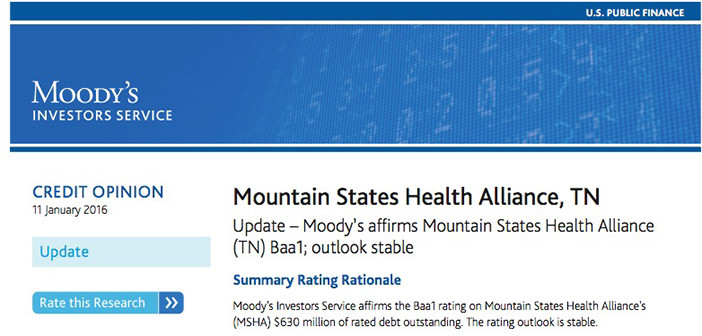Click Here for Final Report
Moody’s Investors Services released its most recent ratings update for Mountain States Health Alliance Monday, affirming its Baa1 rating. The rating outlook remains stable, a trend uninterrupted for 10 years.
From 2008-2015, Moody’s maintained a negative outlook for the not-for-profit hospital sector as a whole, revising its outlook to stable in August 2015. In 2012, Moody’s downgraded a record $20 billion in not-for-profit hospital debt. Even as the not-for-profit sector has seen such downgrades, Mountain States has maintained its ongoing stability, generating favorable reports affirming its ratings and stable outlook each year, notwithstanding the incurrence of debt related to major investment in the region’s health care infrastructure.
“Our board and management team have been working together to help our system navigate a challenging time for hospitals,” said Mountain States’ President and CEO Alan Levine.
In its report, Moody’s cited several strengths of Mountain States, including:
• “Leading and growing market share”
• “Improvement in operating margin in FY 2015”
• “Operating cash flow margin consistently strong given high depreciation”
• “Strong cash on hand…well exceeding the Baa1 median of 161”
• “Strong management team and engaged board focused on growth and financial improvement with strategies that include increased productivity, managing labor and solidifying physician relations”
Moody’s cites that Mountain States Health Alliance has embarked on a strategy to pare back its debt, with a debt reduction plan approved by the board of directors in 2014.
As referenced by Moody’s, Mountain States incurred significant debt during a period of growth as several hospitals were acquired, new hospitals were built and major investment was made in existing facilities in communities throughout the region.
Despite these positive changes, the system’s debt remains the primary factor preventing an upgrade.
The report called Mountain States’ debt-to-operating revenue “very high” at 101 percent. Another credit challenge listed was the system’s “complex debt structure,” which includes multiple bank agreements and a large swap portfolio.
And it listed “high exposure to government payors” – 51 percent Medicare and 14 percent TennCare/Medicaid as a percentage of gross revenues – as an additional credit challenge.
Continued deleveraging (debt reduction), if it is accompanied by improved ratios in debt-to-operating revenue, debt-to-cash flow and cash-to-debt could lead to an upgrade, Moody’s noted, as could “maintenance of favorable financial performance and liquidity measures.”
Even as significant debt reduction has taken place since 2014, Mountain States has invested more than $110 million in capital since July 2014 through cash flow rather than borrowing.
The significant investment in these community assets leads to higher depreciation expense. In addressing this expense, Moody’s cited strong operating cash flow margins, saying they are “consistently strong given high depreciation.”




